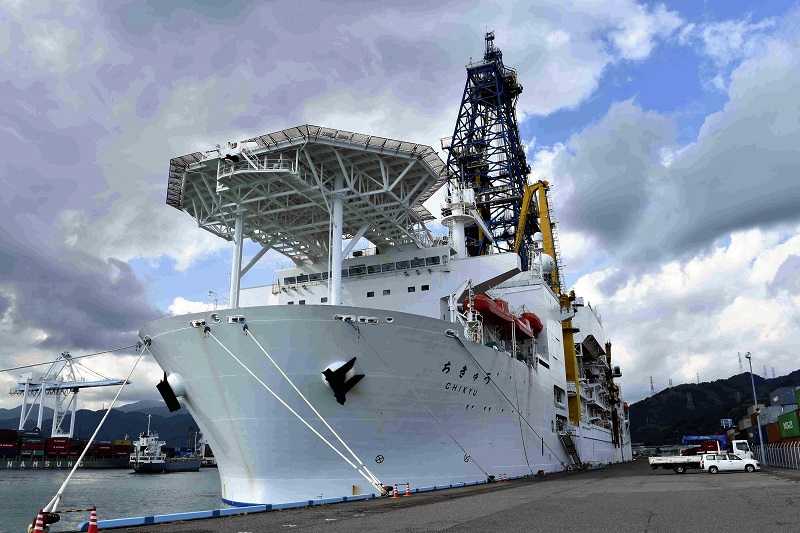
Deep earth exploration vessel Chikyu is seen at Shimizu Port in Shizuoka in October 2018.
17:06 JST, October 31, 2022
Extracting rare earths from mud in the seabed 6,000 meters undersea is being considered by the government.
Domestic procurement of such mineral resources, which are essential for the production of electronic devices, is important for the nation to break its dependence on imports of rare earths from China.
In 2012, rare-earth mud was found in the seabed of the exclusive economic zone around Minami-Torishima Island of Tokyo’s Ogasawara Islands.
The amount of rare-earth reserves around the island is estimated to be equivalent to several hundred years of domestic consumption.
The government will begin technological development in the next fiscal year to establish an extraction method for the resources. Within five years, exploratory extraction will be conducted, with plans to establish efficient rare-earth extraction and production methods. One aim is to create an environment that will allow private enterprises to enter the field from fiscal 2028. Related expenses will be included in the second supplementary budget for fiscal 2022.
Extraction will make use of technology successfully tested off the coast of Ibaraki Prefecture early this year as part of a project run by the Cabinet Office.
The test involved the deep earth exploration vessel Chikyu of the Japan Agency for Marine-Earth Science and Technology (JAMSTEC). The Chikyu extended a riser pipe into the seabed at a depth of 2,470 meters and was able to pump up about 70 tons of mud per day. This was the first time in the world that the technology has been demonstrated to be able to bring up a large amount of mud from the seafloor.
From the next fiscal year onward, the government will strengthen pumps and extend riser pipes to cope with deeper sea, with a goal of exploiting 350 tons per day.
In China, rare earths can be extracted from mines. It will be a challenge for Japan to see how much it can lower the costs of pumping up rare-earth mud from the deep seabed.
Rare earths is the collective term for 17 elements, including scandium and yttrium. A decrease in the supply of these resources would hinder the production of items such as smartphones, computers and next-generation automobiles. Currently, Japan relies almost entirely on imports, 60% of which come from China.
China is tightening its control over exports of rare earths, raising concerns about the risk of supply disruptions. For this reason, the government intends to designate rare earths as one of the “specified critical commodities” in which it is involved in ensuring supply, based on the economic security promotion law.

"Business" POPULAR ARTICLE
-

As Chinese Tourists Shun Japan, Hotels and Stores Suffer
-

Osaka-Kansai Expo’s Economic Impact Estimated at ¥3.6 Trillion, Takes Actual Visitor Numbers into Account
-

Japan Govt Adopts Measures to Curb Mega Solar Power Plant Projects Amid Environmental Concerns
-

BOJ Gov. Ueda: Highly Likely Mechanism for Rising Wages, Prices Will Be Maintained
-

Economic Security Panels Debate Supply Chains, Rare Earths; Participants Emphasize Importance of Cooperation Among Allies
JN ACCESS RANKING
-

As Chinese Tourists Shun Japan, Hotels and Stores Suffer
-

Osaka-Kansai Expo’s Economic Impact Estimated at ¥3.6 Trillion, Takes Actual Visitor Numbers into Account
-

Japan Govt Adopts Measures to Curb Mega Solar Power Plant Projects Amid Environmental Concerns
-

BOJ Gov. Ueda: Highly Likely Mechanism for Rising Wages, Prices Will Be Maintained
-

Economic Security Panels Debate Supply Chains, Rare Earths; Participants Emphasize Importance of Cooperation Among Allies


























